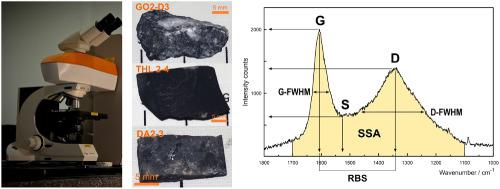当前位置:
X-MOL 学术
›
J. Raman Spectrosc.
›
论文详情
Our official English website, www.x-mol.net, welcomes your feedback! (Note: you will need to create a separate account there.)
Raman spectroscopy as a tool for provenancing black limestones (bigi morati) used in antiquity
Journal of Raman Spectroscopy ( IF 2.5 ) Pub Date : 2020-07-25 , DOI: 10.1002/jrs.5948 Simona Raneri 1 , Filip Košek 2 , Lorenzo Lazzarini 3 , Dagmara Wielgosz‐Rondolino 4 , Jan Jehlicka 2 , Fabrizio Antonelli 3
Journal of Raman Spectroscopy ( IF 2.5 ) Pub Date : 2020-07-25 , DOI: 10.1002/jrs.5948 Simona Raneri 1 , Filip Košek 2 , Lorenzo Lazzarini 3 , Dagmara Wielgosz‐Rondolino 4 , Jan Jehlicka 2 , Fabrizio Antonelli 3
Affiliation

|
Among precious stones used in antiquity, bigi morati stand out for their importance. They consist in black limestones mainly employed in sculptures and architectural heritages and quarried from several sites through the Mediterranean area. Their provenance is difficult to assess due to their similar appearance to the naked‐eye observation and the possible confusion with black marbles (i.e., bigi antichi). Classical methods used for studying ancient marbles, such as minero‐petrographic and stable isotopes analyses (δ13C and δ 16O), resulted to be powerful in provenancing these black lithotypes. However, these methods are microdestructive and cannot be always applied in the case of precious artefacts for which sampling is not allowed. Bearing carbonaceous matter conferring them the typical black‐dark grey colour, Raman spectroscopy might support studies on these limestones, bringing important information about the structural state of organic/carbonaceous matter and their geological evolution. In this study, the potential of Raman spectroscopy in determining geological and geographic provenance of bigi morati was tested on quarry samples from six among the most famous ancient exploitation sources. The obtained results demonstrated that the use of Raman parameters typical of low‐ordered carbon matter is an effective tool in discriminating provenance. Moreover, the laboratory‐based approach lays the groundwork for future development and validation of the method for in situ measurements on artefacts by using portable equipment.
中文翻译:

拉曼光谱法作为出产古代使用的黑色石灰石(bigi morati)的工具
在古代使用的宝石中,bigi morati因其重要性而脱颖而出。它们由黑色石灰石组成,主要用于雕塑和建筑遗产,并从整个地中海地区的多个地点采石。由于它们的外观与肉眼观察相似,并且可能与黑色大理石(即bigi antichi)混淆,因此很难评估它们的来源。用于研究古弹子,如minero-岩相和稳定的经典方法同位素分析(δ 13 C和δ 16O),因此在证明这些黑色石版画方面很有用。但是,这些方法具有微破坏性,不能在不允许进行采样的珍贵文物的情况下始终使用。拉曼光谱法带有碳质物质,使它们具有典型的黑-暗灰色,可能支持对这些石灰石的研究,带来有关有机/碳质物质的结构状态及其地质演化的重要信息。在这项研究中,拉曼光谱法在确定比吉莫拉蒂地质和地理来源方面的潜力对来自六个最著名的古代开采资源的采石场样本进行了测试。获得的结果表明,使用低序碳质物质典型的拉曼参数是区分来源的有效工具。此外,基于实验室的方法为将来开发和验证通过使用便携式设备对人工制品进行原位测量的方法奠定了基础。
更新日期:2020-07-25
中文翻译:

拉曼光谱法作为出产古代使用的黑色石灰石(bigi morati)的工具
在古代使用的宝石中,bigi morati因其重要性而脱颖而出。它们由黑色石灰石组成,主要用于雕塑和建筑遗产,并从整个地中海地区的多个地点采石。由于它们的外观与肉眼观察相似,并且可能与黑色大理石(即bigi antichi)混淆,因此很难评估它们的来源。用于研究古弹子,如minero-岩相和稳定的经典方法同位素分析(δ 13 C和δ 16O),因此在证明这些黑色石版画方面很有用。但是,这些方法具有微破坏性,不能在不允许进行采样的珍贵文物的情况下始终使用。拉曼光谱法带有碳质物质,使它们具有典型的黑-暗灰色,可能支持对这些石灰石的研究,带来有关有机/碳质物质的结构状态及其地质演化的重要信息。在这项研究中,拉曼光谱法在确定比吉莫拉蒂地质和地理来源方面的潜力对来自六个最著名的古代开采资源的采石场样本进行了测试。获得的结果表明,使用低序碳质物质典型的拉曼参数是区分来源的有效工具。此外,基于实验室的方法为将来开发和验证通过使用便携式设备对人工制品进行原位测量的方法奠定了基础。


























 京公网安备 11010802027423号
京公网安备 11010802027423号